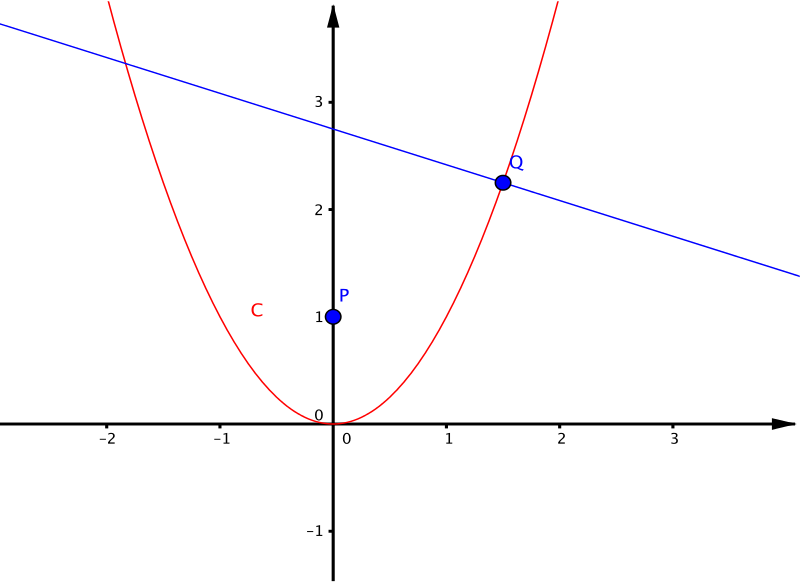As shown in the diagram below: \(C\) is the parabola with equation \(y=x^2\); \(P\) is the point \((0,1)\); \(Q\) is the point \((a,a^2)\) on \(C\); \(L\) is the normal to \(C\) which passes through \(Q\).

- Find the equation of \(L\).
Firstly we need to find the gradient of \(C\) at \(Q\). To do this we differentiate \(y=x^2\) to get \[\frac{dy}{dx}=2x,\] and so at \(Q\) the gradient of \(C\) is \(2a\).
Now we use the fact that (gradient of normal) \(\times\) (gradient of tangent) \(= -1\), so the gradient of \(L\) is \(-\dfrac{1}{2a}\).
BUT beware! This causes trouble when \(a=0\), so we’ll have to consider this case separately.
Now \(L\) is a straight line of the form \(y=mx+c\), where \(m\) is the gradient and \(c\) is a constant.
So we substitute in \(y=a^2\), \(x=a\) and \(m=-\dfrac{1}{2a}\) to find that \(c=a^2 + \dfrac{1}{2}\), and the equation of \(L\) is \[y=-\frac{1}{2a} x + \frac{1}{2} + a^2, \quad\quad (a \neq 0),\] and when \(a=0\), the coordinates of \(Q\) are \((0,0)\) and the gradient at \(Q\) is \(0\), so the equation of the normal \(L\) is \[x=0.\]
- For what values of \(a\) does \(L\) pass through \(P\)?
First we should notice that \(a=0\) is a solution, as the line \(x=0\) passes through \(P\).
Then we substitute the coordinates of \(P\) into the equation for \(L\) (\(a \neq 0\)) to find the other possible values for \(a\).
So \[1=-\frac{1}{2a}(0) + \frac{1}{2} + a^2,\] which we can rearrange to get \[a^2=\frac{1}{2},\] and so our solutions are \[a=\pm \frac{1}{\sqrt{2}}, 0.\]
- Determine \(\big |QP\big |^2\) as a function of \(a\), where \(\big |QP\big |\) denotes the distance from \(P\) to \(Q\).
We can use Pythagoras here, giving
\[\big |QP\big |^2 = (a^2-1)^2 + (a-0)^2 = a^4-2a^2 +1 +a^2 = a^4 - a^2 +1. \]
Note that \(\dfrac{d}{da}\big |QP\big |^2 = 4a^3-2a = 2a(2a^2-1) = 0\) when \(a=\pm \dfrac{1}{\sqrt{2}}, 0\).
Thus the points on the parabola we’ve identified where \(L\) goes through \(P\) are stationary points for \(\big |QP\big |^2\), and thus for \(\big |QP\big |\).
- Find a point \(R\), in the \(xy\)-plane but not on \(C\), such that \(\big |RQ\big |\) is smallest for a unique value of \(a\). Briefly justify your answer.
There are lots of possible answers!
Perhaps the simplest example is a point of the form \((0,-b)\) for some positive \(b\), since it’s easy to see that the unique point on \(C\) which it is closest to is the origin.
Any point \(R\) on \(L\) and ‘outside’ the parabola will count, since \(Q\) will be the unique point closest to \(R\) (because the parabola’s gradient is always increasing).
But as \(Q\) moves around the parabola, any point ‘outside’ \(C\) will be on some normal through \(Q\), and so will be a possible \(R\).
In fact, the only points not closest to a unique point on \(C\) (and which are not on \(C\) itself) are the points on the positive \(y\)-axis.

